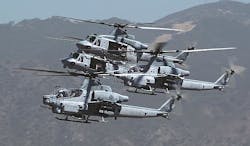Northrop Grumman gets order for more VME-based helicopter aviation mission computers
Officials of the U.S. Naval Air Systems Command at Patuxent River Naval Air Station, Md., are asking the Northrop Grumman Mission Systems segment in Woodland Hills, Calif., for 50 tech refresh mission computers and trays in support of Lot 14 of the H-1 military helicopter program.
Two months ago Northrop Grumman won an $18.3 million order for tech refresh mission computers and trays for the H-1 program. The H-1 Upgrade program is replacing aging AH-1W and UH-1N helicopters with upgraded AH-1Z Super Cobra and UH-1Y Super Huey attack and utility helicopters to enhance commonality, reliability, and maintainability.
The Northrop Grumman Gen III mission computers are the heart of the company's Integrated Avionics System (IAS) that powers the glass cockpit avionics of the UH-1Y and AH-1Z helicopters. The UH-1Y and AH-1Z helicopters are in full production by Bell Helicopter Textron Inc. in Fort Worth, Texas.
The Northrop Grumman conduction-cooled Gen III Technical Refresh mission computer incorporates a ruggedized 6U VME PowerPC-based single board computer. Interfaces include Fast Ethernet, four serial ports, parallel I/O, and built-in-test. FlightPro has a standard partitioned real-time operating system called INTEGRITY-178 tuMP for multicore architectures from Green Hills Software in Santa Barbara, Calif., with ARINC 653 and POSIX support.
The mission computer's standard configuration also includes a quad channel 1553 mezzanine card, high-speed serial card, digital I/O module with eight channels of opto-coupled discrete inputs, eight channels of opto-coupled discrete outputs, and 16 channels of general-purpose bi-directional discretes that can be programmed individually as outputs or inputs.
The flight computers use 28-volt DC or 115-volt AC three-phase 400 Hz input power, measure 13.61 by 11.5 by 7.55 inches, and weigh 30.4 pounds. The computers have rated 3,200 hours mean time between failures.
The flight computer software is RTCA DO-178C compliant, has ARINC-653 partitioning for safety and security, and complies with the Modular Open Systems Architecture (MOSA) standard. The software is aligned with the Future Airborne Capability Environment (FACE) technical standard, has hardware-independent application software developed to MIL-STD-498, under MIL-STD-882C safety program environmental qualification.
Flight computer hardware is designed to MIL-STD-461D for electro-magnetic compatibility, and is tested to MIL-STD-462 and MIL-STD 810E. FlightPro is conduction cooled, and represents “Quiet Cockpit Technology,” Northrop Grumman officials say.
Related: General Dynamics wins $16.3 million contract for mission computers on Navy EA-18G EW jets
Dual mission computers are the foundation of Northrop Grumman's Integrated Avionics System (IAS) that powers the glass cockpits of the Super Cobra and Super Huey helicopters. The mission computers provide centralized control of the IAS and display situational awareness and health monitoring information.
Additionally, the IAS and mission computers can accommodate future system upgrades; rapid insertion of new technologies; and integration of other avionics, communications, and survivability equipment. Northrop Grumman also provides the operational flight program software that controls the IAS.
On this contract Northrop Grumman will do the work in Baltimore; Salt Lake City; and Woodland Hills, Calif., and should be finished by July 2019. For more information contact Northrop Grumman Mission Systems online at www.northropgrumman.comor Naval Air Systems Command at www.navair.navy.mil.
Learn more: search the Aerospace & Defense Buyer's Guide for companies, new products, press releases, and videos

